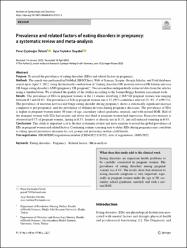| dc.contributor.author | Çiçekoğlu Öztürk, Pınar | |
| dc.contributor.author | Taştekin Ouyaba, Ayşe | |
| dc.date.accessioned | 2023-05-15T11:32:51Z | |
| dc.date.available | 2023-05-15T11:32:51Z | |
| dc.date.issued | 2023 | en_US |
| dc.identifier.citation | Çiçekoğlu Öztürk, P., & Taştekin Ouyaba, A. (2023). Prevalence and related factors of eating disorders in pregnancy: a systematic review and meta-analysis. Archives of Gynecology and Obstetrics, 1-15. | en_US |
| dc.identifier.issn | 1432-0711 | |
| dc.identifier.uri | https://dx.doi.org/0.1007/s00404-023-07051-3. | |
| dc.identifier.uri | https://hdl.handle.net/20.500.12933/1534 | |
| dc.description.abstract | Purpose: To reveal the prevalence of eating disorders (EDs) and related factors in pregnancy.
Methods: The search was performed in PubMed, EBSCOhost, Web of Science, Scopus, Google Scholar, and Ovid databases search up to April 3, 2022, using the keywords combination of "(eating disorders OR anorexia nervosa OR bulimia nervosa OR binge eating disorder) AND (pregnancy OR pregnant)". Two researchers independently extracted data from the articles using a standard form. We evaluated the quality of the studies according to the Joanna Briggs Institute assessment tools.
Results: The prevalence of EDs in pregnant women in the 11 studies involving 2,369,520 pregnant women was ranging between 0.5 and 10.6%. The prevalence of EDs in pregnant women was 4.3% (95% confidence interval 2%-9%; I2 = 99.5%). The prevalence of anorexia nervosa and binge eating disorder during pregnancy shows a statistically significant increase compared to pre-pregnancy, and the prevalence of bulimia nervosa during pregnancy decreases. The prevalence of EDs is higher in pregnant women under 30 years of age, secondary school graduates, married, and with normal BMI. Half of the pregnant women with EDs had anxiety and about one-third of pregnant women had depression. Excessive exercise is observed in 0.7% of pregnant women, fasting in 0.3%, laxative or diuretic use in 0.1%, and self-induced vomiting in 0.6%.
Conclusions: This study is important as it is the first systematic review and meta-analysis to reveal the global prevalence of EDs in pregnant women and related factors. Continuing routine screening tests to detect EDs during pregnancy may contribute to taking special preventive measures for risk groups and protecting mother-child health. | en_US |
| dc.language.iso | en | |
| dc.publisher | Springer International | en_US |
| dc.relation.ispartof | Archives of gynecology and obstetrics | |
| dc.rights | info:eu-repo/semantics/embargoedAccess | en_US |
| dc.subject | Eating Disorders | en_US |
| dc.subject | Meta-Analysis | en_US |
| dc.subject | Pregnancy | en_US |
| dc.subject | Related Factors | en_US |
| dc.title | Prevalence and related factors of eating disorders in pregnancy: a systematic review and meta-analysis | en_US |
| dc.type | Article | |
| dc.identifier.orcid | 0000-0002-5907-1140 | en_US |
| dc.department | AFSÜ, Tıp Fakültesi, Cerrahi Tıp Bilimleri Bölümü, Kadın Hastalıkları ve Doğum Ana Bilim Dalı | en_US |
| dc.institutionauthor | Taştekin Ouyaba, Ayşe | |
| dc.identifier.doi | 10.1007/s00404-023-07051-3 | |
| dc.relation.publicationcategory | Makale - Ulusal Hakemli Dergi - Kurum Öğretim Elemanı | en_US |
| dc.identifier.pmid | 37162562 | |
| dc.identifier.scopus | 2-s2.0-85159072321 | |
| dc.identifier.scopusquality | Q2 | |
| dc.identifier.wos | WOS:000985377400003 | |
| dc.identifier.wosquality | Q2 | |
| dc.indekslendigikaynak | Web of Science | |
| dc.indekslendigikaynak | Scopus | |
| dc.indekslendigikaynak | PubMed | |
















